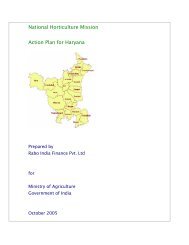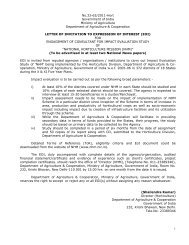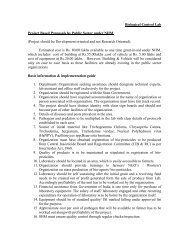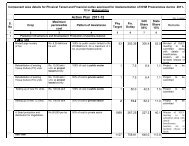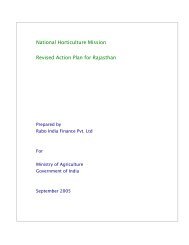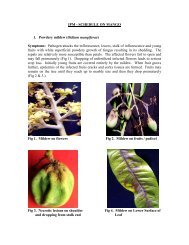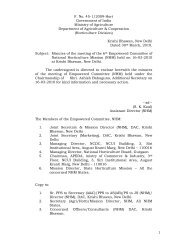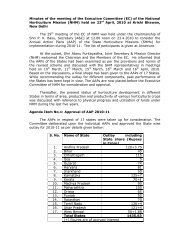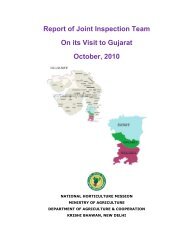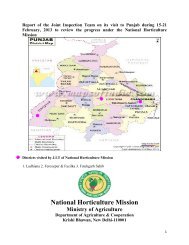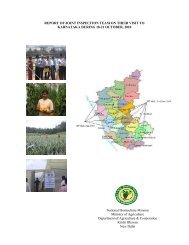Guava - National Horticulture Mission
Guava - National Horticulture Mission
Guava - National Horticulture Mission
You also want an ePaper? Increase the reach of your titles
YUMPU automatically turns print PDFs into web optimized ePapers that Google loves.
4. Lack of timely application of suitable control measures.Management: Following practices are required for the management of the disease:Disease can be kept under check by proper sanitation in the orchard. Wilted treesshould be uprooted, burnt and trench should be dug around the tree trunk.While transplanting, roots of plants should not be damaged severely.Maintenance of proper tree vigour by timely and adequatelyManuring, intercutlure and irrigation enable them to withstand infection.The pits may be treated with formalin and kept covered for about 3 days andtransplanting should be done after two weeks.Organic manures, oil cakes and lime also check the disease.Use of rootstocks resistant to wilt could be an alternative effective method for thecontrol of disease. Cross of Psidium malle x P. guajava has been found free fromwilt and this material can be used as resistant root stock.Eco-friendly approach of guava wilt control is suggested where biological control,soil amendment and intercropping are effective.Biological control by Aspergillus niger strain AN-17 is found effective.Aspergillus niger multiplied in FYM @ 5 kg/pit, applied in the pits while plantingnew plants. In older plants Aspergillus niger enriched FYM can be applied @ 10kg plant 1.Partially wilted plants recovered fully after rejuvenation / heavy pruning of thetree.2. Anthracnose: [Gloeosporium psidii (Delacroix Sacc. = Glomerella psidii (Del.)Sheld./ Colletotrichum psidii Curzi.]Symptoms: Die back phase: The plant begins to die backwards form the top of a branch.Young shoots, leaves and fruits are readily attached, while they are still tender. Thegreenish colour of the growing tip is changed to dark brown and later to black necroticareas extending backwards causing the die back. The fungus develops from the infectedtwigs and then petiole and young leaves. These may droop down or fall leaving the driedtwigs without leaves. The disease appears in epidemic form, during August toSeptember.Fruit and leaf infection phase: Fruit and leaf infection is generally seen in rainyseason crop. Pin-head spots are first seen on unripe fruits, which gradually enlarge.Spots are dark brown in colour, sunken, circular and have minute black stromata in thecenter of the lesion, which produce creamy spore masses in moist weather. Several spotscoalesce to form bigger lesions (Fig 2 &3). The infected area on unripe fruits becomecorky and hardy, and often develops cracks in case of severe infection. Unopened budsand flowers are also affected by disease which caused their shedding. On leaves, thefungus causes necrotic lesions at the tip or on the margin. These lesions are usually ashygrey and bear fruiting bodies.



